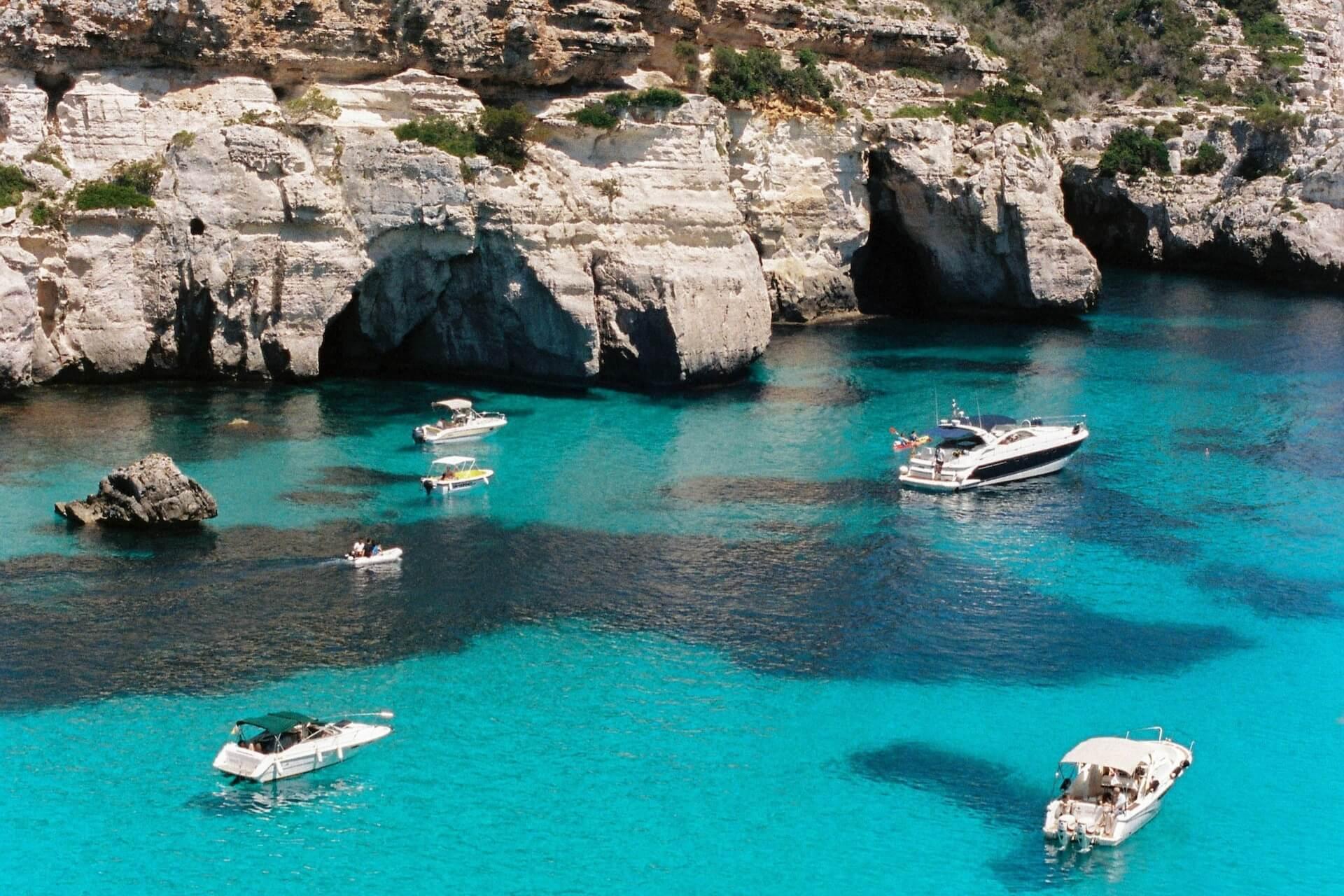Picturesque fishing villages, wild beaches with turquoise water, a wonderful circular route along the coast, beautiful island views and magical sand dunes. Menorca is a charming Balearic island that may lie a little in the shadow of its "grown-up sister" Mallorca. And that's what makes it the perfect destination for anyone looking for peace and quiet.
Basic information
The second largest island of the Balearic archipelago, it is about 50 kilometres long and 16 kilometres wide. You can get around by public transport, but it is more geared up for the high season and often doesn't fully function outside of it. You can get maximum freedom with a rental car. Car rentals are very affordable in the low season, and only reach their heights in June, July and August.
The weather is pleasant, hot in summer. You might get caught in the rain in Menorca – it's said to get the same amount of rain a year as in the UK, except that it rains less often and more intensely here. If you want to experience the tranquillity and real life of the island, come in the off-season in spring/summer or autumn.
Mahon, fishing villages and the island’s scenic viewpoint
When you arrive on the island, take some time to explore the main town of Mahon. Situated in a five-kilometre bay, up to 900 metres wide in some places, the town has one of the largest natural harbours in the western Mediterranean. From the harbour, which is lined with pubs, bars and restaurants, boats leave several times a day for the so-called Hospital Island. There, in addition to the old, inaccessible hospital building, you will also find the newly opened Hauser & Wirth gallery with its modern art, which has breathed new life into the island in recent years. If you have time, be sure to have a meal at the local restaurant Sa Cantina, the cooking is really great. Once back at the port, you can visit the distillery shop where the traditional Menorcan gin Mahon is produced.
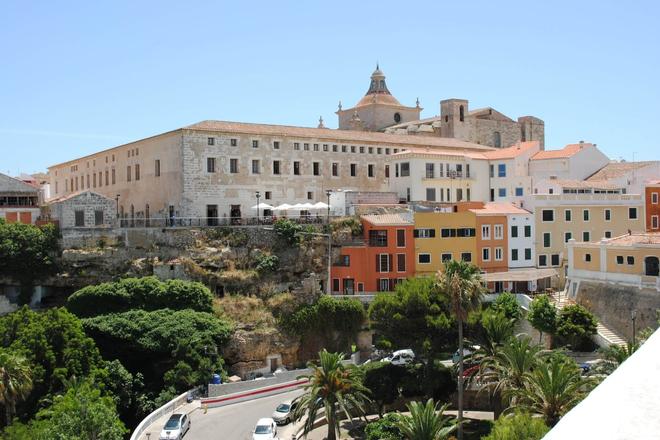
As you drive west from Mahon, stop in the picturesque fishing village of Binibeca just outside Saint Louis. The village is characterised by its narrow winding streets between miniature fishing houses. All of them are meticulously painted white, and although there are only a few dozen, it's easy to wander among them.
There are at least two reasons to stop in Es Mercadal, and they are the traditional restaurant es Molí d'es Racó and the more modern Tast. Both offer fantastic dishes, local specialities. For example, the roast rabbit or the octopus in traditional mayonnaise – Mahonnaise – are great. Try the stuffed vegetables or seafood, you can't go wrong.
To get a better idea of what the island looks like, head to its highest peak with a view of Monte de Toro. It proudly rises to 357 metres from the vantage point – at the top you can see a large part of the whole island. You can drive up the hill and there's a bus that goes up the 3.5km long, winding road. At the top, you'll find the Santuario de la Virgen del Toro church, a several-metre-high statue of Christ, a souvenir shop and a restaurant.
Wandering along the Horse Trail
Around the entire island runs the GD 223 long-distance route, the Camí de Cavalls – the Horse Trail. It's a 190 kilometre circuit that runs largely along the coastline around the whole of Menorca. Its history is several hundred years old. The path not only served as access to the sea when it was necessary to defend the island from raiders, but also connected the various watchtowers and fortresses. It facilitated the advance of troops and artillery in difficult terrain. Although the individual sections were on private land, they were bought up in response to tourist demand and are now all publicly accessible.
The trail is excellently marked around the paths with wooden posts bearing burgundy-red signs, often bearing the name of the place you are passing, or classic mile markers with the distance to the next major point on the trail. Carry plenty of water at all times of the year and wear good shoes for rocky paths.
The entire Camí de Cavalls is divided into twenty sections, the longest of which is just under 14 kilometres. You can therefore decide whether to walk the whole thing, sleeping in a different place each day, or whether you'll start from one place and tackle each section in turn. Or you can simply choose the most beautiful or closest sections to your accommodation during your holiday and just go on these. The whole of the Camí de Cavalls can be walked in seven days, although in that case you'll be looking at a daily allowance of around thirty kilometres. You will need to prepare and arrange accommodation for such a trip, as sleeping in a tent is forbidden in Menorca. In addition, finding accommodation in the off-season (perhaps early spring) can be as tricky as in the high season.
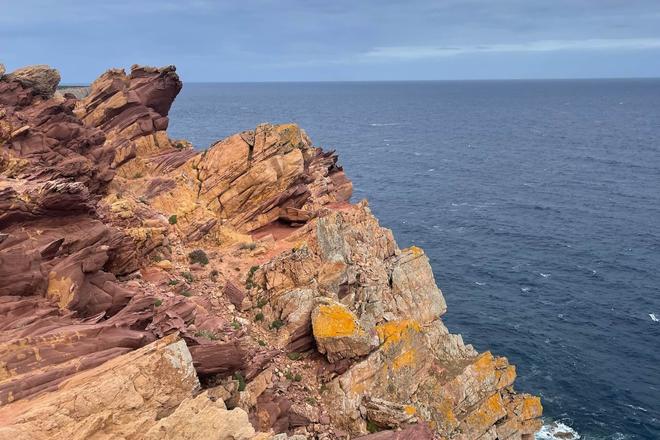
Wetlands, sand dunes, rocky shores and green turtles
Among the most beautiful sections is the Camí de Cavalls route between the lighthouse on Cape Favaritx to the wetlands in the lagoon behind the village of Es Grau. In high season, bus number 43 from Mahon takes you to the Cape. In low season it's more complicated, you'll have to use two cars, a taxi or simply walk the route there and back.
Along the way, you will hike along the beautiful rocky coastline, walk in the shade of the Halep pines, wander through low stands of Fenian juniper and yam trees and through sand dunes. Keep in mind that you are in the Albufera des Grau Nature Park, so please do not wander off the marked trails. Feel free to swim in the sea, the water is crystal clear and most of the beaches are sheltered from the sea in small coves. You'll come across the first beach, Cala Presili, after about a kilometre and a half, with Platja de Capifort a few hundred metres along the route.
You will drive through the sand dunes, one of the most valuable natural features of the Balearic Islands coast. Many endemic plants grow here and many rare animals live here, especially since human intervention has been prevented. Nature has completely regenerated itself in these places. In the sand you can see, for example, the shaggy bracken, more commonly known as the sea buttercup, the white flowers of the sea lily and the yellow flowers of the sea honeydew. Even the common beach grass has its charm. In the animal kingdom, you can see the common guillemot, and in the wetlands behind Es Grau, you can also see eagles or the little egret. A rare greenish turtle also lives in the vegetation around Camí de Cavalls.
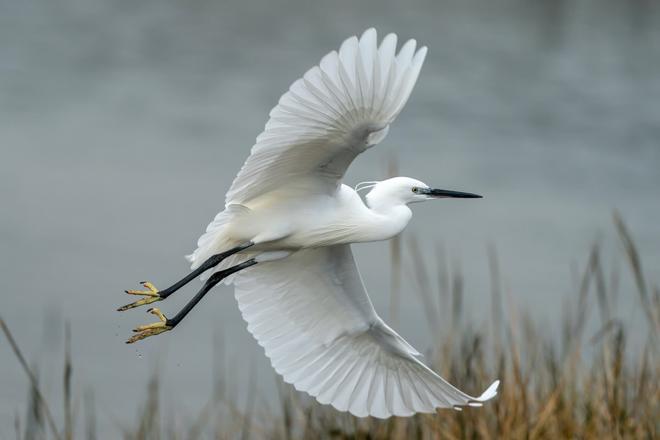
Part of the route also passes through agricultural landscapes and pastures that are used for traditional farming on the island. After about seven kilometres of walking, you can turn off the Horse Trail route and explore the Tower of Rambla – a British coastal defence tower standing on the Rambla promontory that separates Cala de sa Torreta Bay from Cala des Tamarells Bay. It was built between 1799 and 1802, like other similar structures on the coast, to defend the island. You can't get inside due to the poor statics of the building.
Sea kayaking and snorkelling
The most beautiful beaches are along the way to the small seaside village of Es Grau. There are three in Tamarells Bay and they all abound with fine sand. You can walk to them, but it's much more adventurous to arrive by boat. In Es Grau, you can rent a kayak for the day and take it around the coast. One of the nicest beaches is Les Tamarells on a nearby islet. If you're worried, you can also use their guide who will explain everything and take you to the best spots in the area, including the rock caves off the coast.
Also consider snorkelling gear, as almost all the beaches have really varied underwater life. The "litmus test" that the underwater environment is as clean as possible, is the presence of posidonia seagrass, a grass that grows on the sandy bottom. It has an incredible contribution to make to maintaining the natural underwater environment. It provides shelter for a variety of animals and small fish, is a natural protection for the coastline against erosion and wave action and, according to recent research, plays a vital role in cleaning the sea of plastics and microplastics.
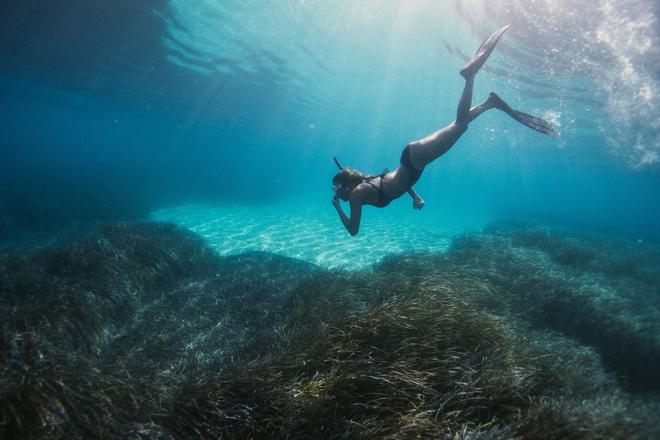
Swimming in Menorca – nudists, wind and nature
Swimming opportunities in Menorca are variable in the spring months. Higher water temperatures of around 23 °C last into the autumn months of September and October. It can be quite windy on the island and locals follow a simple rule: if it's windy in the south of the island, then go to the north coast to swim and vice versa.
Menorca's coastline is lined with beautiful beaches. In the south, the route from Cala Galdana to St. Thomas is definitely worth taking. And again, you can use the Camí de Cavalls trail. Along the route you will find beautiful bays with white sand, such as Cala Mitjana, Cala Escorxada and Cala de Trebalúger. The beaches in the north of the island are similar. For example, the stretch between the Far de Favàritx lighthouse and the small seaside village of Es Grau in the Albufera Natural Park offers a beautiful beach on each of the nine kilometres of the route – for example, Algaiarens and Cavalleria on the road from the lighthouse of the same name. It's a struggle to resist the tempting turquoise blue, clear water, which is 18 °C in spring, but the reward is deserted beaches.
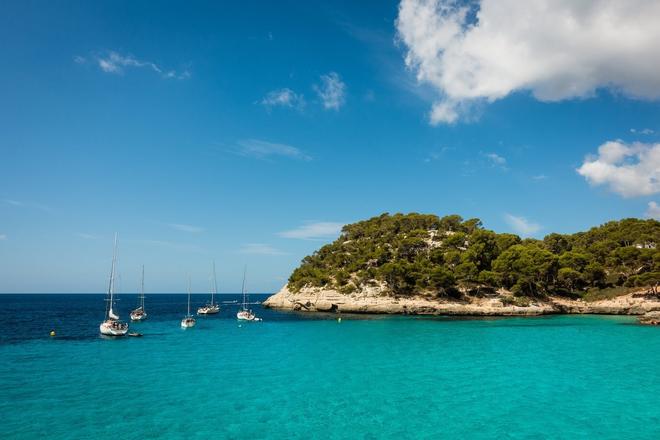
All Menorcan beaches are public and wild. This means they are not spoiled by beach bars or stalls with loud music and snacks. You can usually find restrooms and toilets at the parking lot that belongs to the beach. The concept of wild beaches may suit travellers who aren't into organised resort holidays. The last specificity of Menorca's beaches is the high tolerance for naturists. On most public beaches (beaches for nudists are not specially marked) you will find a few naked people, and for women it is quite common to swim or sunbathe "topless".
